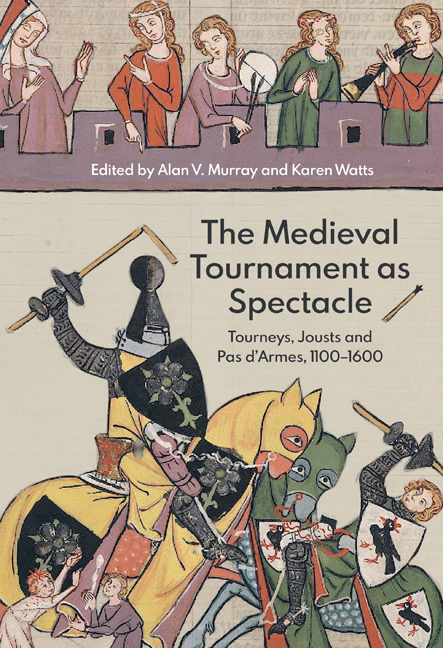Book contents
- Frontmatter
- Contents
- List of Illustrations
- List of Contributors
- Preface and Acknowledgements
- Introduction: From Mass Combat to Field of Cloth of Gold
- Research on the Medieval Tournament (1100–1600): A Select Bibliography
- 1 Now Form Up Close Together! Tactics and Ethos of the Tourney in Early German Sources (Twelfth to Thirteenth Centuries)
- 2 Por pris et por enor: Ideas of Honour as Reflected in the Medieval Tournament
- 3 Richard II of England and the Smithfield Tournament of October 1390: An Instrument to Establish Royal Authority
- 4 Alle myn harneys for the justes: Documents as a Source for Medieval Jousting Armour
- 5 The Tournament Saddle
- 6 Between Sport and Theatre: How Spectacular was the Pas d’armes?
- 7 Art Imitating Life Imitating Art? Representations of the Pas d’armes in Burgundian Prose Romance: The Case of Jehan d’Avennes
- 8 The Foot Combat as Tournament Event: Equipment, Space and Forms
- 9 Power and Pageantry: The Tournament at the Court of Maximilian I
- 10 The Field of Cloth of Gold: Arms, Armour and the Sporting Prowess of King Henry VIII and King Francis I
- Appendix 1 Calendar of the Royal Combats at the Field of Cloth of Gold, June 1520
- Appendix 2 Articles for the Challenge: The Emprise
- Index of Objects
- Index of Manuscripts
- General Index
10 - The Field of Cloth of Gold: Arms, Armour and the Sporting Prowess of King Henry VIII and King Francis I
Published online by Cambridge University Press: 11 September 2020
- Frontmatter
- Contents
- List of Illustrations
- List of Contributors
- Preface and Acknowledgements
- Introduction: From Mass Combat to Field of Cloth of Gold
- Research on the Medieval Tournament (1100–1600): A Select Bibliography
- 1 Now Form Up Close Together! Tactics and Ethos of the Tourney in Early German Sources (Twelfth to Thirteenth Centuries)
- 2 Por pris et por enor: Ideas of Honour as Reflected in the Medieval Tournament
- 3 Richard II of England and the Smithfield Tournament of October 1390: An Instrument to Establish Royal Authority
- 4 Alle myn harneys for the justes: Documents as a Source for Medieval Jousting Armour
- 5 The Tournament Saddle
- 6 Between Sport and Theatre: How Spectacular was the Pas d’armes?
- 7 Art Imitating Life Imitating Art? Representations of the Pas d’armes in Burgundian Prose Romance: The Case of Jehan d’Avennes
- 8 The Foot Combat as Tournament Event: Equipment, Space and Forms
- 9 Power and Pageantry: The Tournament at the Court of Maximilian I
- 10 The Field of Cloth of Gold: Arms, Armour and the Sporting Prowess of King Henry VIII and King Francis I
- Appendix 1 Calendar of the Royal Combats at the Field of Cloth of Gold, June 1520
- Appendix 2 Articles for the Challenge: The Emprise
- Index of Objects
- Index of Manuscripts
- General Index
Summary
The Field of Cloth of Gold was a summit meeting held in the summer of 1520 at which Henry VIII, king of England, and Francis I, king of France, jousted, tourneyed and fought on foot against knights of both courts. It was the first time that the two young kings met and it served to demonstrate to each other that they were physically powerful potentates. It is interesting to assess how these two kings reacted to each other. This chapter will uniquely consider the arms and armour of the two kings and their participation in the combats of the Field of Cloth of Gold. Rather than being suspicious of each other and acting as rivals, we can see the two kings revelling in each other’s company, in every sense.
The tournament was named after the magnificent and very costly cloth-ofgold pavilions embellishing an otherwise drab setting in the Pale of Calais, a wetland region in northern France captured by Edward III and the only part of mainland France to remain in English control at the end of the Hundred Years’ War. It was one of the most extraordinary tournaments of the period. Even today it is a byword for chivalry and extravagance. The scene-setting for the Field of Cloth of Gold was certainly elaborate. The palace, pavilions of cloth of gold and the tournament lists (arenas) were erected especially for the event and removed afterwards. It is remarkable that no physical trace of the tournament remains today.
The political and diplomatic intentions, planning, organisation and implications of the Field of Cloth of Gold have been discussed and put into context by French and English historians. There are numerous and sometimes contradictory primary sources including reports, accounts of revels, letters and chronicles. Sir Richard Wingfield was appointed ambassador at the French court and his letters to Cardinal Wolsey and to King Henry VIII are revealing as he reports candidly on King Francis I during the organisation of the tournament. The most detailed English source is Edward Hall, whose Chronicle, first printed in 1548, is invaluable as it uses an eyewitness account. A standard French source, the memoir of Guillaume du Bellay, together with various pamphlet commemorations, offers information about the sequence of events.
This essay, however, will consider a unique eyewitness source: the Maréchal de Fleuranges.
- Type
- Chapter
- Information
- The Medieval Tournament as SpectacleTourneys, Jousts and Pas d'Armes, 1100-1600, pp. 208 - 228Publisher: Boydell & BrewerPrint publication year: 2020



